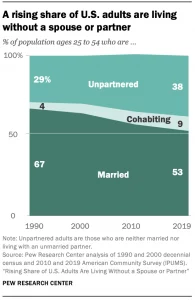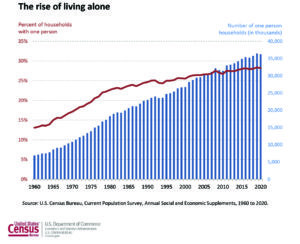If you look around your congregation and realize there are a lot more young and middle-aged single adults than there used to be, you’re not alone. It’s a national trend.
New data from Pew Research finds a sharp uptick over the past 30 years in the number of unpartnered American adults ages 25 to 54. Analysis of Census data from 2019 reveals that 38% of adults in that age bracket were neither married nor living with a partner — up from 29% in 1990.
Further, men are now more likely than women to be unpartnered, which wasn’t true 30 years ago. And among that group of unpartnered men, about three in 10 are living in a home with one or both parents.
 “The growth in the single population is driven mainly by the decline in marriage among adults who are at prime working age,” Pew explained. At the same time, there has been a rise in the share who are cohabiting, but it hasn’t been enough to offset the drop in marriage — hence the overall decline in partnership. While the unpartnered population includes some adults who were previously married (those who are separated, divorced or widowed), all of the growth in the unpartnered population since 1990 has come from a rise in the number who have never been married.”
“The growth in the single population is driven mainly by the decline in marriage among adults who are at prime working age,” Pew explained. At the same time, there has been a rise in the share who are cohabiting, but it hasn’t been enough to offset the drop in marriage — hence the overall decline in partnership. While the unpartnered population includes some adults who were previously married (those who are separated, divorced or widowed), all of the growth in the unpartnered population since 1990 has come from a rise in the number who have never been married.”
Among 25- to 54-year-olds in 1990, 67% were married. Today, only 53% of that demographic are married — a 14-point decrease. However, the share of that age group who are cohabiting with an unmarried partner has more than doubled, from 4% in 1990 to 9% in 2019.
Today, 33% of American adults ages 25 to 54 have never been married.
“Some may assume that, as the median age of first marriage continues to rise, unpartnered adults are merely lagging behind rather than foregoing partnership altogether,” Pew said. “That might not be the case. Among adults ages 40 to 54, there has been a significant increase in the share who are unpartnered from 1990 (24%) to now (31% in 2019).”
 The Pew analysis also found differences based on race and ethnicity. Among prime working age Americans (ages 25 to 54) Asian adults were the least likely to be unpartnered (33%), followed by white adults (33%), Hispanic adults (38%) and Black adults (59%).
The Pew analysis also found differences based on race and ethnicity. Among prime working age Americans (ages 25 to 54) Asian adults were the least likely to be unpartnered (33%), followed by white adults (33%), Hispanic adults (38%) and Black adults (59%).
There are notable economic differences between adults who are partnered compared to those with no partner, the study found.
“Cohabiting adults tend to fare better than unpartnered adults, and married adults fare better still,” the authors reported. “On many dimensions, cohabiting adults are more similar to married adults than to single adults. There are exceptions as well as differences by gender. For example, among women, those in cohabiting relationships (80%) are more likely to be employed than unpartnered (77%) or married (73%) women. Among men, while those who cohabit (89%) are less likely to be employed than those who are married (92%), they’re much more likely than single men to have a job (73%).”
In sum, Pew reported: “Looking across a range of measures of economic and social status, unpartnered adults generally have different — often worse — outcomes than those who are married or cohabiting. This pattern is apparent among both men and women. Unpartnered adults have lower earnings, on average, than partnered adults and are less likely to be employed or economically independent. They also have lower educational attainment and are more likely to live with their parents. Other research suggests that married and cohabiting adults fare better than those who are unpartnered when it comes to some health outcomes.”
 This data corresponds to Census Bureau findings that both the number and percentage of all American adults who live alone have been increasing since 1960. In that year, about 7% of all U.S. households were individuals living alone. By 2020, that had grown to about 32%.
This data corresponds to Census Bureau findings that both the number and percentage of all American adults who live alone have been increasing since 1960. In that year, about 7% of all U.S. households were individuals living alone. By 2020, that had grown to about 32%.
Related articles:
Single adult numbers are soaring. What does that mean for congregations?
Churches must improve treatment of singles or risk losing them, author says


